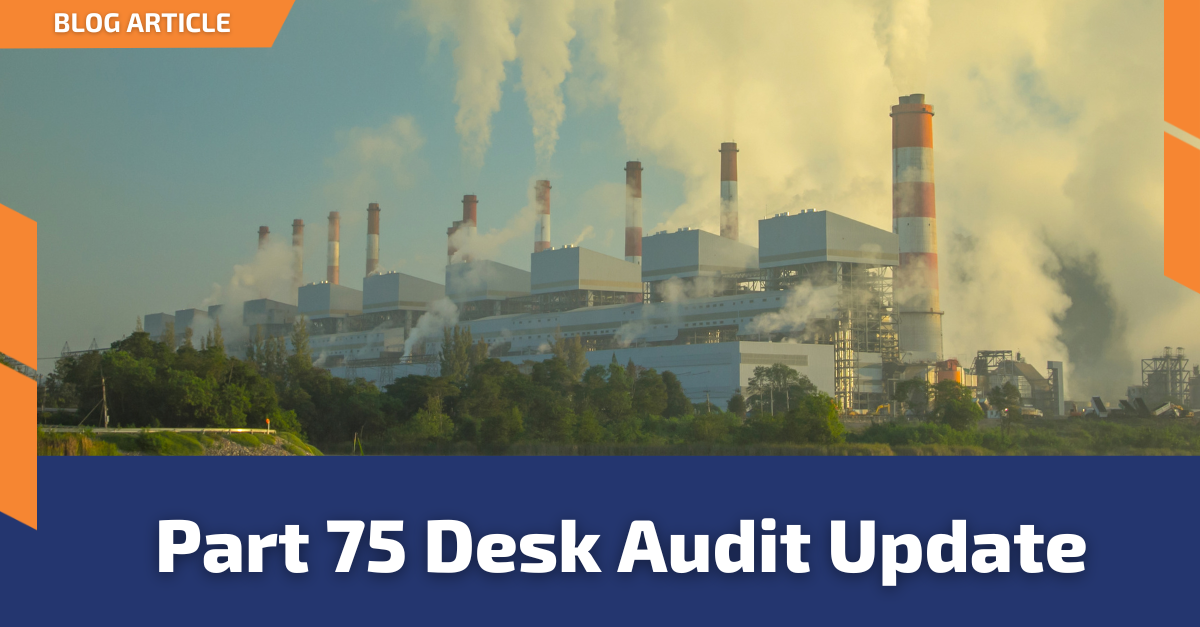The Clean Air & Power Division (CAPD), formerly known as the Clean Air Markets Division (CAMD), continues to conduct virtual Part 75 continuous emission monitoring system (CEMS) program audits referred to as “Part 75 Desk Audits.” Initially, the Desk Audits primarily focused on coal-fired units equipped with full CEMS. Part 75 Desk Audits are conducted by CAPD personnel or contractors and typically last approximately four (4) months. Ongoing communication is handled via emails and/or conference calls. Information requested from the plant usually includes:
- Quality Assurance/Quality Control (QA/QC) Plan
- Hardcopy Monitoring Plan, including all schematics and diagrams
- Latest relative accuracy test audit report
- Targeted CEMS logbook entries for previous year
- Various photos of CEMS shelter, analyzer serial numbers, and images of current daily calibration error test and linearity check PGVP cylinder certifications.
These audits also included a review of the QA/QC requirements for mercury (Hg) CEMS and/or Hg sorbent trap monitoring systems used for compliance with Subpart UUUUU to Part 63 (aka The MATS Rule).
During the May 2024 EPRI CEMUG Conference, CAPD gave a presentation which discussed expanding the scope of the Part 75 Desk Audits to include requirements and checklists specific to gas- and oil-fired units using Appendix D & NOx CEMS as well as peaking units utilizing Appendix E NOx correlation curves. In addition to the standard information request listed above, some checks specific to gas- and oil-fired units include, but are not limited to:
- Documentation that the fuel meets the definition of pipeline natural gas (PNG) or natural gas (NNG).
- Verification that fuel flow is corrected to EPA “standard conditions” as defined in §72.2
- Fuel sampling procedures
- Fuel flowmeter QA test procedures
The CAPD presentation also discussed conducting Appendix D correlation checks to detect discrepancies in reporting heat input. In general, the check compares hourly heat input values at the same load bin in two adjacent calendar quarters. The check only considers bins 5 – 10 and there must be at least 168 hourly values or more in a bin. CAPD stated that their initial analysis showed that most Appendix D units reported consistent heat input data. In a few cases, issues with fuel flowmeter “scaling factors” required resubmission of quarterly emissions files.
VIM has reviewed a draft Appendix D checklist from the Part 75 Desk Audit Manual and is ready to help. VIM has successfully conducted numerous CEMS program audits. Audits can be tailored to assess compliance with air permit requirements, 40 CFR Part 75, 40 CFR Part 60, 40 CFR Part 63 and Greenhouse Gas Reporting rule specifications. A comprehensive audit can provide an objective assessment of compliance with the applicable federal and State regulations and evaluate the efficiency of your overall CEMS program. During the audit, VIM conducts a detailed review of the QA Plan, Monitoring Plan, CEMS maintenance logs, corrective maintenance activities, and associated standard operating procedures. VIM also reviews the data acquisition and handling system (DAHS) to ensure that calculations are performed correctly.
VIM typically conducts a review of documentation prior to performing an on-site inspection of CEMS equipment and other site records. This process makes the site visit more efficient, requiring less time for your busy plant staff. VIM’s findings and recommendations are submitted in a formal report. If you’re interested in hearing more about the Part 75 Appendix D Desk Audit guidance or an audit for your facility, please contact Dru Sanders at dru.sanders@vimtechnologies.com or at (410) 859-5455 Ext. 4051.




